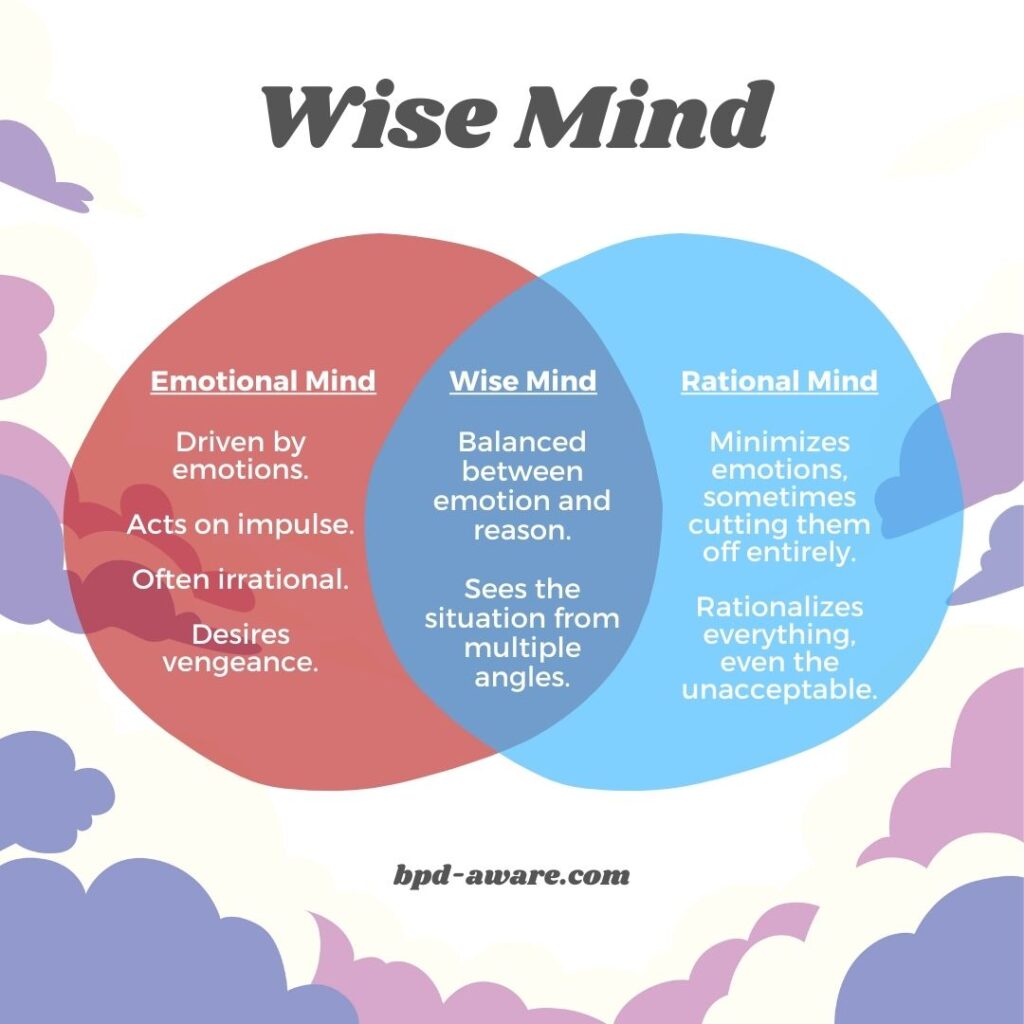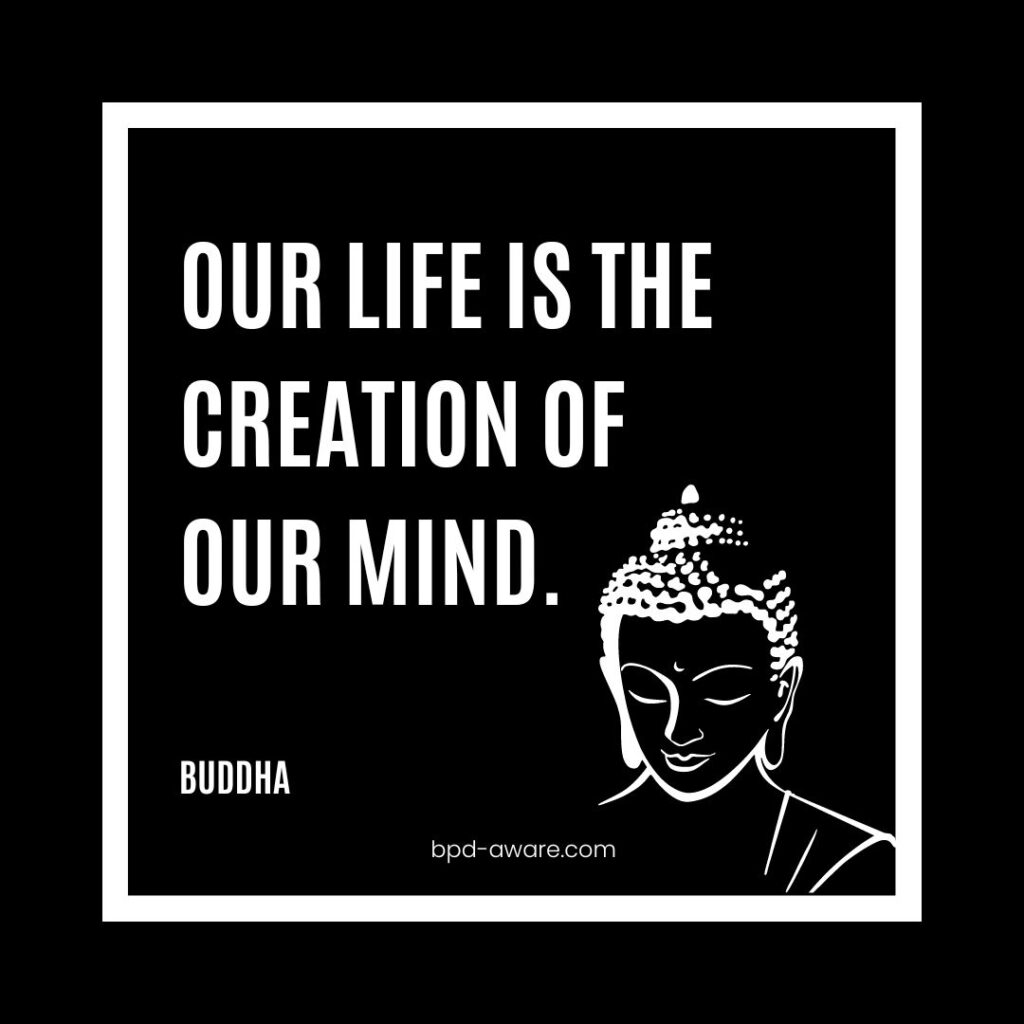Wise Mind is one of the most crucial concepts in Dialectical Behavior Therapy (DBT) and is designed to help people achieve a balanced state of mind. For people with Borderline Personality Disorder (BPD), who tend to think in a black-and-white manner, Wise Mind can be incredibly useful.
So, what is Wise Mind? Wise Mind represents the merging of two states: the Emotional Mind and the Rational Mind.
The Emotional Mind is driven by feelings and impulses. This is the state of mind that people with BPD are in most of the time. Living in the Emotional Mind state leads to reactive and irrational behavior. For example, if you don’t hear back from a friend for an hour after you’ve sent them a message, you may start to believe that they hate you and don’t want to talk to you anymore. There is little evidence for this and it’s far more likely they’re just busy, but the Emotional Mind takes over and makes you think the worst.
The Rational Mind is governed by logic and facts, think of Spock from Star Trek or Sheldon Cooper from Big Bang Theory. Living in a Rational Mind state can lead to minimizing the importance of emotions, acting coldly, and rationalizing unacceptable behavior. For example, your partner may be acting unacceptably but you rationalize staying with them because a break-up would be too messy.
Wise Mind is balancing these two states so that emotions and logic can exist together and guide the individual so they may make thoughtful, balanced decisions. This balanced state leads to more effective decision-making and emotional regulation.
Wise Mind is central to all DBT skills and practices. Think of it as the foundation on which the other skills are built. Cultivating the Wise Mind greatly enhances mindfulness, distress tolerance, and interpersonal effectiveness – the four core components of DBT.

Delving Deeper Into Wise Mind
We now know that Wise Mind represents a balance between the emotional and rational parts of our mind, but there’s more to Wise Mind than that. Wise Mind is also characterized by a sense of clarity and calmness – that sense of zen. When you have a well-developed Wise Mind, you can be in the moment and see situations more clearly. Your mind isn’t clouded by emotions or rigid logic. This sense of clarity carries over to all aspects of your life.
As mentioned previously, Wise Mind leads to more effective decision-making. Decisions aren’t made from rash emotional responses or cold, hard logic. Both emotion and rationale are taken into account, reducing the likelihood of impulsive or overly analytical behavior. When you develop your Wise Mind and use it to make decisions, you start to make the choices that lead to a better, more balanced life.
When you make better decisions, you will find that your life begins to improve in many ways. You will be better able to manage intense emotions, reduce impulsivity, communicate more effectively, resolve conflicts in a healthy manner, and build more stable relationships. On top of that, when you marry the Emotional and Rational Minds into Wise Mind, you will have a greater understanding of your thoughts and feelings.
Accessing Wise Mind
Accessing your Wise Mind is something that takes time and practice. There are several techniques you can use to access Wise Mind that we will split into their appropriate categories.
Mindfulness
Observe Your Thoughts and Feelings Without Judgment
Whenever you have an emotional reaction to something, observe exactly what this reaction is. What emotions and thoughts come to your mind? Take some time to consider both the Emotional Mind and the Rational Mind. Whatever your reaction, don’t judge it, just let it happen. Meditate on why you are reacting the way you are. Did something similar happen to you in the past? Are there other issues at play?
Stay Present in the Moment
Staying present in the moment is an essential mindfulness practice. Take a little time each day to focus on the here and now. Forget the past, you can’t change it, and forget the future because it’s not here yet. Guided meditation is an excellent way to stay in the moment, but something as simple as watching a bird going about its business outside your window can help you stay in the moment.
Breathing Exercises
Deep Breathing Techniques
Deep breathing techniques are an effective way to calm the mind and reduce emotional reactions. Focus on your breathing and take several slow, deep breaths. Notice how cool the air feels as you inhale and how energizing that can be. Feel the warmth of the air as it leaves your body. If possible, close your eyes and allow yourself to focus deeply. This will activate the body’s relaxation response, creating the space for balanced thinking.
Square Breathing
Square breathing is a simple yet powerful way to practice staying present. Get comfortable, close your eyes, and take a few natural breaths. Picture a square in your mind’s eyes. Inhale deeply through your nose while mentally tracing one side of the box to the count of 4. Hold your breath to the count of 4 while tracing the next side. Exhale to the count of 4 while mentally tracing the next side. Finally, hold your breath again to the count of 4 while tracing the final side of the box. You can repeat this for a few minutes.
The 4-7-8 Breathing Technique
Begin by getting comfortable and close your eyes. Take a few natural breaths and allow yourself to settle. Once you feel relaxed, inhale through your nose to the count of 4. Hold that breath until the count of 7. Then exhale slowly through your nose to the count of 8 while making a whooshing sound. Repeat this cycle four times. This is a breathing technique designed to reduce anxiety, which can help you enter a Wise Mind state.
Visualization Techniques
Guided Imagery
Guided imagery involves visualizing a peaceful place in which you can spend some time and relax. You can choose the same place each time or try new places within your mind. For example, you may wish to visualize yourself on a beach. The warm glow of the sun in the sky, the sounds of the gentle lapping of the deep, blue ocean, and the feel of the sand beneath your body. Spend as much time as you like here.
There are also many guided meditation and hypnosis videos and MP3s online that you can follow where an instructor will guide you through this kind of experience if you struggle on your own.
Wise Mind Figure
Rather than visualizing a place, you might prefer to visualize a person or being that represents your Wise Mind. It can be someone you know or a completely imaginary figure. Talk to your Wise Mind Figure and listen to their input.
Decision-Making Strategies
HALT
HALT stands for Hungry, Angry, Lonely, Tired. Assess your state before you make an important decision. If you are any of these four things, you’re unlikely to be in the best position to make a Wise Mind decision.
Pause and Reflect Before Making A Decision
Giving yourself a moment to pause, take a breath, and reflect upon the situation before making a decision is an important part of accessing Wise Mind. This helps you to take too much emotion out of your decision. However, it’s equally important not to ruminate and spend too much time on a decision as this can remove emotion entirely and make the process analytical. It’s about finding balance. This can be difficult at first, but it does become difficult with practice.
Weighing Emotional and Rational Inputs
Wise Mind isn’t about completely removing emotion from your mind, it’s about considering both emotional and rational inputs and finding a balance. When you have an important decision to make, you can create a list of Emotional and Rational Mind inputs – much like a pros and cons list. This can be done mentally or you can physically write a list.

Tips For Practicing Wise Mind
Understanding the concept of Wise Mind and knowing techniques that help you enter that state is only half the battle. You need to incorporate at least some of these techniques into your daily routine.
Pick one (or more) technique from each category: Mindfulness, Breathing Exercises, Guided Imagery, and Decision-Making Strategies. Set aside some time each day to practice them. For example, you might want to practice staying present in the moment after you wake up. Look outside your window and allow the experience to wash over you. During the day, when faced with a decision, give yourself the chance to pause and reflect. At lunch, you could take a couple of minutes to speak to your Wise Mind Figure. Finally, during the evening you could practice some square breathing. All told, this doesn’t have to take up more than fifteen minutes of your day but the benefits can be huge.
It can be challenging at first to practice Wise Mind. That part of your mind may be under-exercised, or you might feel silly about imagining a conversation with a Wise Mind Figure. That’s perfectly natural. Give it a real try though and you’ll find it becomes easier with time.
Eventually, it’s Wise Mind that will feel natural.
Sources, Resources, and Further Reading
- Wise Mind: DBT Skills, Worksheets, Videos, Exercises: https://dialecticalbehaviortherapy.com/mindfulness/wise-mind/
- The Wise Mind: https://www.therapistaid.com/therapy-worksheet/wise-mind
- Can someone explain Wise Mind in a more simplified way?: https://www.reddit.com/r/dbtselfhelp/comments/xun33n/can_someone_explain_wise_mind_in_a_more/
















